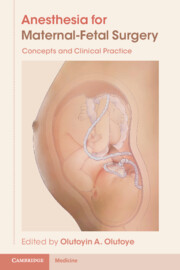Book contents
- Anesthesia for Maternal-Fetal Surgery
- Anesthesia for Maternal-Fetal Surgery
- Copyright page
- Dedication
- Contents
- Contributors
- Abbreviations
- Preface
- Acknowledgments
- Section 1
- Chapter 1 Physiology of Pregnancy
- Chapter 2 Fetal Physiology and Fetal Pain
- Chapter 3 Ethical Considerations for Maternal-Fetal Surgery
- Chapter 4 Multidisciplinary Approach to Fetal Surgery
- Chapter 5 Intrauterine Transfusion
- Section 2
- Section 3
- Index
- Endmatter
- References
Chapter 5 - Intrauterine Transfusion
from Section 1
Published online by Cambridge University Press: 19 November 2021
- Anesthesia for Maternal-Fetal Surgery
- Anesthesia for Maternal-Fetal Surgery
- Copyright page
- Dedication
- Contents
- Contributors
- Abbreviations
- Preface
- Acknowledgments
- Section 1
- Chapter 1 Physiology of Pregnancy
- Chapter 2 Fetal Physiology and Fetal Pain
- Chapter 3 Ethical Considerations for Maternal-Fetal Surgery
- Chapter 4 Multidisciplinary Approach to Fetal Surgery
- Chapter 5 Intrauterine Transfusion
- Section 2
- Section 3
- Index
- Endmatter
- References
Summary
Hemolytic disease of the fetus and newborn is a common cause of intrauterine death and increased neonatal morbidity. While this condition may occur as a result of maternal antibody formation to a variety of different antibodies,(alloimmunization), that which occurs in response to the Rhesus D antigen is the most common. Many centers now perform intrauterine fetal blood transfusion, a required mode of therapy for alloimunization, which is necessary to prevent fetal demise. The ability to accurately detect and treat fetuses affected by this condition depends on adequate prenatal care, astute maternal-fetal practitioners, and a robust center with the ability to analyze fetal blood samples which directs transfusion therapy. While intrauterine therapy is not without complications, and is commonly characterized by repeated fetal transfusions, the ability to transfuse fetuses in-utero has drastically improved the prognosis for affected babies.
Keywords
- Type
- Chapter
- Information
- Anesthesia for Maternal-Fetal SurgeryConcepts and Clinical Practice, pp. 64 - 82Publisher: Cambridge University PressPrint publication year: 2021

